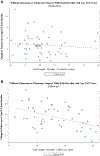Globe Axial Length Growth at Age 10.5 Years in the Infant Aphakia Treatment Study
- PMID: 32304705
- PMCID: PMC7593806
- DOI: 10.1016/j.ajo.2020.04.010
Globe Axial Length Growth at Age 10.5 Years in the Infant Aphakia Treatment Study
Abstract
Purpose: To report the change in globe axial length (AL) from the time of unilateral cataract surgery at age 1-7 months to age 10.5 years for infants enrolled in the Infant Aphakia Treatment Study, and to compare AL growth of operated eyes with that of fellow unoperated eyes.
Design: Comparative case series.
Methods: AL growth was analyzed relative to treated vs fellow eye, contact lens (CL) vs intraocular lens (IOL), visual acuity (VA) outcome, and the need for surgery for visual axis opacification. Eyes with glaucoma or glaucoma suspect were excluded from the primary analysis but reported separately.
Results: Fifty-seven patients have reliable AL data available at both visits. AL was shorter in treated eyes preoperatively (P < .0001) and at 10.5 years of age (P = .021) but AL growth was not different (4.7 mm, P = .99). The growth (70.2% up to age 5 and 29.8% from age 5 to 10.5) was similar in the CL and the IOL group (P = .79). Eyes grew 4.4 mm when visual acuity (VA) was better than 20/200, and 5.2 mm when VA was 20/200 or worse (P = .076). Eyes receiving additional surgery grew more than eyes not receiving additional surgery (P = .052). Patients with glaucoma showed significantly more eye growth (7.3 mm) than those without glaucoma (4.7 mm) and glaucoma suspects (5.1 mm) (P < .05).
Conclusions: Eyes with glaucoma or poor VA often grew longer than the fellow eye. Overall, treated eyes grew similarly in the IOL and CL groups and also kept pace with the growth of the fellow eyes.
Copyright © 2020 Elsevier Inc. All rights reserved.
Figures




References
Publication types
MeSH terms
Grants and funding
LinkOut - more resources
Full Text Sources
Medical

